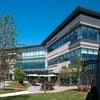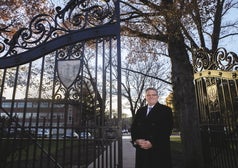Worcester State to cap off $200M upgrade
On Tuesday, Worcester State University will cut the ribbon on its new wellness center, the final facility upgrade in a $200-million campaign started back in 2000. All the changes – which include new residence hall capacity and more common spaces for students to gather – is part of a larger effort to convert the school from a commuter university largely serving Central Massachusetts to one that can attract students from across the country. President Barry Maloney, who celebrated his five-year anniversary at WSU on July 1, said the upgrades were the result of listening to what students were asking for.
Why did you want to be WSU president?
One of things that was attractive to me before I arrived was the campus was on the move before I arrived. The former president (Janelle C. Ashley) had positioned the campus very well, which I continued.
One of those things that was continued was a commitment that started in the year 2000 to improve the physical face of the university, starting with the Ghosh Science & Technology Center. It was a new commitment to the sciences, and it definitely has been a building that falls into adage of “If you build it, they will come.” Our science majors have been more robust in their enrollment, and we have new developing areas, like our concentration in green chemistry.
What were some other critical buildouts?
I came in when we were building out the residential component of the institution, and that is a significant change for Worcester State. Worcester State’s legacy is one of being a commuter institution. We have served students here in Worcester County for 140+ years.
It has only been for the last 20-25 years that you have seen a growth in residential hall capacity on campus. One of the projects that was developed and finished in my tenure was Sheehan Hall, which is a new 400-bed residence hall, dining hall and health center.
How does that fit into the WSU mission?
The residence hall capacity not only helps us recruit students from outside of Massachusetts but also helps us retain those students once we have recruited them. That is critically important.
The dining hall not only gives our students a place to dine but a place to gather. That is something that has been in short supply on campus – common spaces for students to gather, recreate and congregate.
These are things the students were asking for.
What will the wellness center offer WSU?
We are looking to recruit students and to retain them, and that is embedded in all capital projects. With the wellness center project, we had a facility built in the 1950s back when the enrollment was 400 students. Now if you count full-time, part-time, undergraduate and graduate students, we are at about 6,000, which is a substantial change. The facility, like our dining facility, just wasn’t the right fit.
For our wellness center project, we actually tore down our old gymnasium and repurposed that space because we don’t have a lot of space to expand outward.
Why is expansion for facilities difficult?
You don’t have to look hard around our campus to know we are located in a great part of Worcester, a very residential part of Worcester that is thriving. We are landlocked because we are surrounded by great neighbors. That helps our front door of our neighborhood, but it means our ability to expand the campus is limited.
How will the community benefit?
I’m very excited about the wellness center in terms of the project components we can have with the community. We fully expect over the course of this year, we will be developing programming with the Worcester community. We haven’t been able to do that in awhile; when you don’t have the right facilities, it is difficult to do that.
In the years ahead, we will be a player in high school tournaments, high school activities, community-based programs, camps, seminars, all kinds of fun stuff that we just haven’t been able to be a part of.
On Tuesday, Worcester State University will cut the ribbon on its new wellness center, the final facility upgrade in a $200-million campaign started back in 2000. All the changes – which include new residence hall capacity and more common spaces for students to gather – is part of a larger effort to convert the school from a commuter university largely serving Central Massachusetts to one that can attract students from across the country. President Barry Maloney, who celebrated his five-year anniversary at WSU on July 1, said the upgrades were the result of listening to what students were asking for.
Why did you want to be WSU president?
One of things that was attractive to me before I arrived was the campus was on the move before I arrived. The former president (Janelle C. Ashley) had positioned the campus very well, which I continued.
One of those things that was continued was a commitment that started in the year 2000 to improve the physical face of the university, starting with the Ghosh Science & Technology Center. It was a new commitment to the sciences, and it definitely has been a building that falls into adage of “If you build it, they will come.” Our science majors have been more robust in their enrollment, and we have new developing areas, like our concentration in green chemistry.
What were some other critical buildouts?
I came in when we were building out the residential component of the institution, and that is a significant change for Worcester State. Worcester State’s legacy is one of being a commuter institution. We have served students here in Worcester County for 140+ years.
It has only been for the last 20-25 years that you have seen a growth in residential hall capacity on campus. One of the projects that was developed and finished in my tenure was Sheehan Hall, which is a new 400-bed residence hall, dining hall and health center.
How does that fit into the WSU mission?
The residence hall capacity not only helps us recruit students from outside of Massachusetts but also helps us retain those students once we have recruited them. That is critically important.
The dining hall not only gives our students a place to dine but a place to gather. That is something that has been in short supply on campus – common spaces for students to gather, recreate and congregate.
These are things the students were asking for.
What will the wellness center offer WSU?
We are looking to recruit students and to retain them, and that is embedded in all capital projects. With the wellness center project, we had a facility built in the 1950s back when the enrollment was 400 students. Now if you count full-time, part-time, undergraduate and graduate students, we are at about 6,000, which is a substantial change. The facility, like our dining facility, just wasn’t the right fit.
For our wellness center project, we actually tore down our old gymnasium and repurposed that space because we don’t have a lot of space to expand outward.
Why is expansion for facilities difficult?
You don’t have to look hard around our campus to know we are located in a great part of Worcester, a very residential part of Worcester that is thriving. We are landlocked because we are surrounded by great neighbors. That helps our front door of our neighborhood, but it means our ability to expand the campus is limited.
How will the community benefit?
I’m very excited about the wellness center in terms of the project components we can have with the community. We fully expect over the course of this year, we will be developing programming with the Worcester community. We haven’t been able to do that in awhile; when you don’t have the right facilities, it is difficult to do that.
In the years ahead, we will be a player in high school tournaments, high school activities, community-based programs, camps, seminars, all kinds of fun stuff that we just haven’t been able to be a part of.
Video














0 Comments